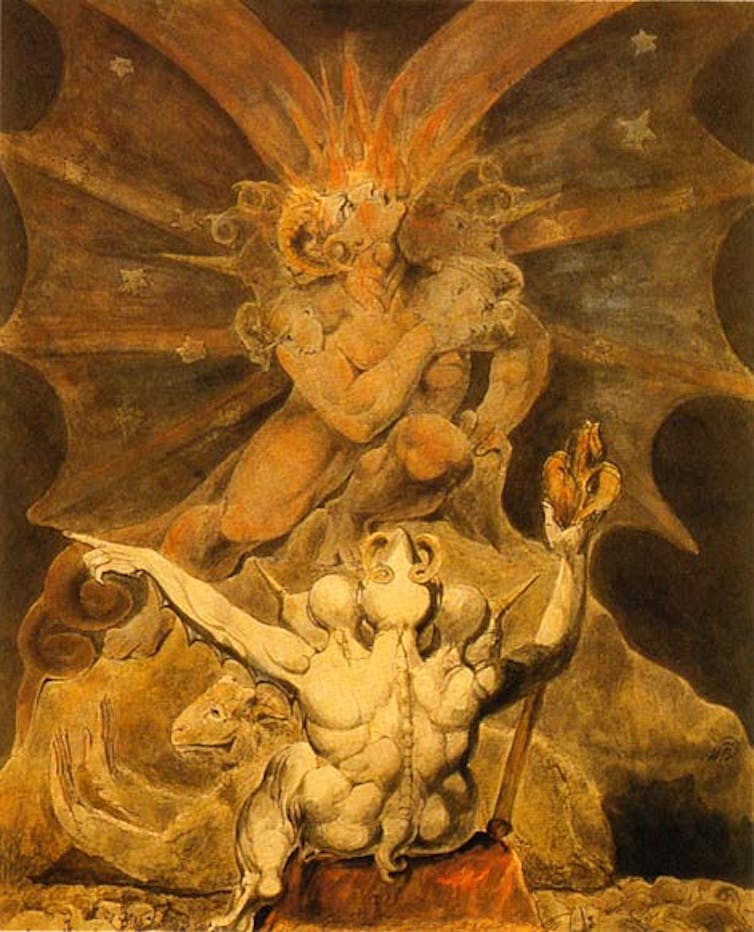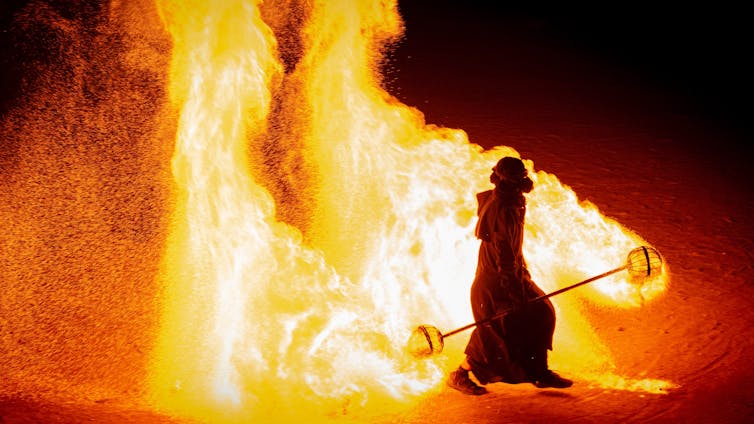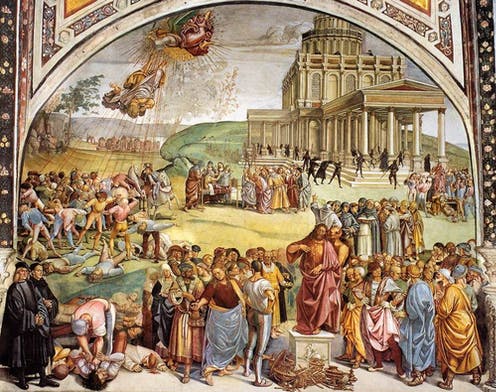In the history of the West over the last 2000 years, there has never been a time when someone hasn’t been predicting the end of the world.
And now, with a seemingly insoluble climate crisis, pandemic surges, savage wildfires and hurricanes, and a renewed nuclear arms race, seems no time to stop.
Many of us feel, as poet John Donne put it in The Anatomy of the World in 1611, “Tis all in pieces, all coherence gone”.
The Christian tradition tells us to be on the lookout for the Antichrist, who will appear shortly before the big finish. Vast amounts of Christian ink have been used to try and work out when he will come and just how we might identify him when he does.
Here, then, are five things to know just in case:
1. He is the Son of Satan
The Antichrist was the perfectly evil human being because he was completely opposite to the perfectly good human being, Jesus Christ.
Just as Christians came to believe that Jesus Christ was the Son of God, so they thought that the Antichrist was the Son of Satan. Jesus was born of a virgin. So the Antichrist would be born of a woman who was apparently a virgin, but was really a whore. Where Christ was God in the flesh, the Antichrist was Satan in the flesh.
In The Christian New Testament there are only three passages that mention the Antichrist, all in the letters of John (I John 2.18-27, I John 4.1-6, 2 John 7). They suggest the end of the world should be expected at any moment.
Over the first several centuries of the Christian tradition, the scholars of the early Church started to pore over an array of other Biblical characters finding references to the Antichrist within them: the “abomination of desolation” in the books of Daniel and Matthew; “the man of lawlessness” and “the son of perdition” in a letter of Paul.
The book of Revelation describes a singular figure as “the beast from the earth” and “the beast from the sea” whose number is 666.
 William Blake’s The number of the beast is 666 (1805-1810). Wikiart
William Blake’s The number of the beast is 666 (1805-1810). Wikiart
2. He is an earthly tyrant and trickster
By the year 1000, the main outlines of the first of two narratives about the Antichrist was in place thanks to a noble-born Benedictine monk and abbot named Adso of Montier-en-Der (c. 920-92) who wrote a treatise on the subject.
According to him, the Antichrist would be a Jew from the tribe of Dan and born in Babylon. He would be brought up in all forms of wickedness by magicians and wizards. He would be accepted as the Messiah and ruler by the Jews in Jerusalem. Those Christians whom he could not convert to his cause, he would torture and kill.
He would then rule for seven years before being defeated by the angel Gabriel or Christ and the divine armies, prior to the resurrection of the dead and the Final Judgement.
3. Past popes have been accused
By the year 1400, another narrative of the Antichrist had arisen. Now he was no longer the tyrant outside of the Church but the deceiver within it. In short, he was the Pope or even the institution of the papacy and the Church themselves.
As the English religious radical John Wycliffe (c. 1329-84) put it,
… the Pope may obviously be the Antichrist, and yet not just that sole single individual… but rather the multitude of popes holding that position … along with the cardinals and bishops of the church.
This was the position on the Antichrist adopted by Protestants at the time of the 16th century Reformation. Martin Luther (1483-1546) was convinced that he was living in the last days. For him, the Pope fitted all the criteria for the Antichrist. The Pope, he declared, “is the true end times Antichrist who has raised himself over and set himself against Christ”.
 Popes, old and new, have been targets for those on the lookout for the Antichrist. Unsplash/Nacho Arteaga, CC BY
Popes, old and new, have been targets for those on the lookout for the Antichrist. Unsplash/Nacho Arteaga, CC BY
4. He is one and many
Within conservative Christianity over the last century, Antichrists have multiplied. “The Antichrist” has become a general category available for application to an array of individuals, collectives, and objects as the demonic “other”.
Generally, predictions of a tyrant outside the church now dominate the idea of a deceiver within it.
American presidents are well represented When it comes to accusations of being the Antichrist, usually from the conservative religious right, Ronald Reagan, John F. Kennedy, and Barack Obama have all been mentioned. Donald Trump is gaining popularity as a worthy candidate with ethics scholar D. Stephen Long suggesting he represents: “not a single person but a political pattern that repeats itself by taking on power to oppress the poor and the just”.
American evangelist Jerry Falwell, known for his controversial views on apartheid, homosexuality, Judaism, climate change and the Teletubbies, once said: “The Antichrist will be a world leader, he’ll have supernatural powers”.
Hilary Clinton is, to the best of my knowledge, the only female candidate. US Republican politician Ryan Zinke who was US Secretary of the Interior in the Trump Administration from 2017 until his resignation in 2019, threw the accusation in 2014. She later reassured him, at Trump’s inauguration, that she wasn’t.
Osama bin Laden was a favourite until his death, as was Saddam Hussein.
Marks of the beast have even been discerned by some in supermarket barcodes and pet microchips.
 How close are we to a fiery end? Unsplash/Alexandre Boucey, CC BY
How close are we to a fiery end? Unsplash/Alexandre Boucey, CC BY
5. He dies in the end
According to the Christian tradition, the Antichrist will finally be defeated by the armies of God under the leadership of Christ with the Kingdom of God (on earth or in heaven) to follow.
So, in spite of current appearances, Christianity holds firmly to the hope that evil will be finally overcome and that goodness will ultimately prevail.
The core idea of the Antichrist — of evil at the depths of things — lays upon all of us the ethical imperative to take evil seriously. Whether the end is nigh or not, we should work to minimise harm and maximise the good in the here and now.



 What is a migrant? What is ICE? 10 terms to help you understand the debate over immigration
What is a migrant? What is ICE? 10 terms to help you understand the debate over immigration  Ontario’s high-stakes bet on iGaming: Province profiting from online betting but at what cost to problem gambling?
Ontario’s high-stakes bet on iGaming: Province profiting from online betting but at what cost to problem gambling?  American studies degrees are declining in popularity – but the subject has never been more important
American studies degrees are declining in popularity – but the subject has never been more important  Elon Musk Dispatches Tesla Team to Recover Cybertruck Video After Las Vegas Explosion Shocks the Nation
Elon Musk Dispatches Tesla Team to Recover Cybertruck Video After Las Vegas Explosion Shocks the Nation  New Orleans Attacker Confirmed to Have Acted Alone as DHS Secretary Addresses National Concerns
New Orleans Attacker Confirmed to Have Acted Alone as DHS Secretary Addresses National Concerns  Explosives Stockpile Uncovered in Virginia Farm as FBI Probes Terror Ties to Recent US Attacks
Explosives Stockpile Uncovered in Virginia Farm as FBI Probes Terror Ties to Recent US Attacks  Food and medicine that can change your skin colour – sometimes permanently
Food and medicine that can change your skin colour – sometimes permanently  Five commercials that show how David Lynch elevated advertising to an art form
Five commercials that show how David Lynch elevated advertising to an art form  Soaring wealth inequality has remade the map of American prosperity
Soaring wealth inequality has remade the map of American prosperity  Mandatory Masks in Health Care Sparks Outrage as New York, New Jersey, and California Enforce Winter Rules
Mandatory Masks in Health Care Sparks Outrage as New York, New Jersey, and California Enforce Winter Rules  Entrepreneurs need to be protected from burnout too
Entrepreneurs need to be protected from burnout too  Missing Black Box Data Deepens Mystery of Jeju Air Crash
Missing Black Box Data Deepens Mystery of Jeju Air Crash  How religion’s brand became unpopular in Canada
How religion’s brand became unpopular in Canada 
































